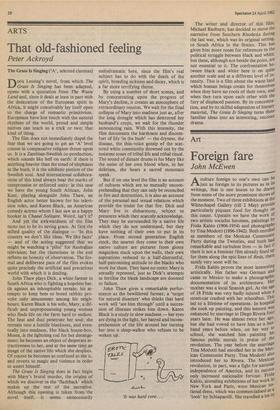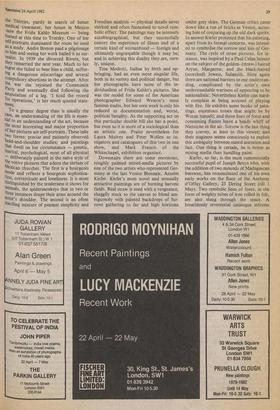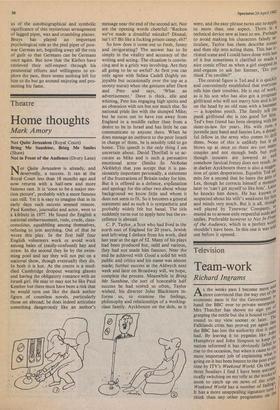Foreign fare
John McEwen
Aculture foreign to one's own can be just as foreign in its pictures as in its writings, that is one lesson to be drawn from some of the more prominent shows of the moment. Two of three exhibitions at the Whitechapel Gallery (till 2 May) provide particularly piquant food for thought on this count. Upstairs we have the work of two artistic socialist heroines, paintings by Frida Kahlo (1906-1954) and photograPbs by Tina Modotti (1896-1942). Both enrolled as members of the Mexican Communist, Party during the Twenties, and both had remarkable and turbulent lives — in fact If there is not a feminist film already lined uP for them along the epic lines of Reds, there surely very soon will be.
Frida Kahlo proves the most interesting artistically. Her father was German and came to Mexico to make a photographic documentation of its architecture. Her mother was a local Spanish girl. At the age of 18 Frida was very badly injured when a street-car crashed with her schoolbus. This led to a lifetime of operations. In hospital she took up painting, and this interest was enhanced by marriage to Diego Rivera four years later. He was almost twice her age, but she had vowed to have him as a hus- band years before when, on her way to school, she watched him painting his famous public murals in praise of the revolution. The year before the marriage Tina Modotti had enrolled her in the Mex" ican Communist Party. Tina Modotti also introduced her to Rivera. The Mexican revolution, in part, was a fight for national independence of America, and its success only increased nationalist fervour. Frida Kahlo, attending exhibitions of her work in New York and Paris, wore Mexican na- tional dress, which was commercialised as a. 'look' by Schiaparelli. She travelled a lot in the Thirties, partly in search of better medical treatment, her house in Mexico -now the Frida Kahlo Museum — being loaned at this time to Trotsky. One of her self-portraits dominated the room he used as a study. Andre Breton paid a pilgrimage to him and seeing her work hailed it as sur- realist. In 1939 she divorced Rivera, but they remarried the next year. Much to her regret she failed to bear him a child, suffer- ing a dangerous miscarriage and several compulsory abortions in the attempt. After the war she rejoined the Communist Party and eventually died following the amputation of a leg. 'I hold the record for operations,' is her much quoted state- ment.
To a greater degree than is usually the ese, an understanding of the life is essen- tial to an understanding of the art, because the most interesting and major proportion of her pictures are self-portraits. These take two forms: precise and patiently observed head-and-shoulder studies; and paintings that dwell on her circumstance — genetic, marital, psychological, most of all physical deliberately painted in the naive style of the votive pictures that adorn the shrines of Mexican churches. The first is a bourgeois Mode and reflects a bourgeois sophistica- tion, correctitude and loneliness. It is most distinguished by the tenderness it shows for animals, the spidermonkeys that in two or three instances drape their arms around the artist's shoulder. The second is an often startling mixture of peasant simplicity and
Freudian analysis — physical details never shirked and often fantasised to novel sym- bolic effect. The paintings may be intensely autobiographical, but they successfully convey the experience of illness and of a certain kind of womanhood — foreign and ultimately ungraspable though it may be; and in achieving this duality they are, sure- ly, unique.
Tina Modotti, Italian by birth and up- bringing, had an even more singular life, both in its variety and political danger, but her photographs have none of the in- dividualism of Frida Kahlo's pictures. She was the model for some of the American photographer Edward Weston's most famous nudes, but her own work is only his reduced to documentation and, worse, political banality. As the supporting act on this particular double bill she has a point, but even so it is more of a sociological than an artistic one. Praise nevertheless for Laura Mulvey and Peter Wollen as in- stigators and cataloguers of this two in one show, and Mark Francis of the Whitechapel, exhibition organiser.
Downstairs there are some enormous, roughly painted mixed-media pictures by one of the two artists who represented Ger- many at the last Venice Biennale, Anselm Kiefer. Kiefer's most novel and sensually attractive paintings are of burning harvest fields. Real straw is used with a vengeance, shaggily stuck to the canvas to blend am- biguously with painted backdrops of fur- rows gathering to far and high horizons under grey skies. The German critics came down like a ton of bricks at Venice, accus- ing him of conjuring up the old dark spirits. In answer Kiefer protested that his painting, apart from its formal concerns, was intend- ed to symbolise the sorrow and loss of Ger- many. The cycle of straw pictures, for in- stance, was inspired by a Paul Celan lament on the subject of the golden- (straw-) haired Aryan, Margarete, and the black-haired (scorched) Jewess, Sulamith. Here again there are national barriers to our understan- ding, complicated by the artist's own understandable wariness of appearing to be nationalistic. Nevertheless Kiefer can hard- ly complain at being accused of playing with fire. He exhibits some books of pain- tings, enormous tomes that might be by Wotan himself; and those lines of force and consuming flames leave a heady whiff of Nietszche in the air. Sorrow is the last thing they convey, at least to this viewer; and their staginess seems consciously to exploit this ambiguity between stated intention and fact. One thing is certain, he is better at mixing media than handling paint.
Kiefer, so far, is the most commercially successful pupil of Joseph Beuys who, with the addition of two mounds of Madagascan beeswax, has reconstituted one of his own early works on the floor of the Anthony d'Offay Gallery, 23 Dering Street (till I May). Two symbolic lines of force, in the form of weighty tubes of iron rolled in felt, are also slung through the space. A breathlessly reverential catalogue informs
us of the autobiographical and symbolic significance of this mysterious arrangement of lagged pipes, wax and crumbling plaster. Beuys has played an important psychological role as the pied piper of post- war German art, beguiling away all the rats of guilt so that Germans can be Germans once again. But now that the Kiefers have retrieved their self-respect through his penitential efforts and willingness to ex- plore the past, there seems nothing left for him to do but go around enjoying and pro- moting his fame.








































 Previous page
Previous page